Bayesian Filtering Multi-Baseline Phase Unwrapping Method Based on a Two-Stage Programming Approach
Abstract
Featured Application
Abstract
1. Introduction
2. MBPU Theory and Phase Gradient Estimation
2.1. Mathematical Foundation of MBPU
2.2. Phase Gradient Estimation
3. Bayesian Filtering MBPU Method
3.1. Multi-Baseline EKFPU Algorithm
3.2. Multi-Baseline CKFPU Algorithm
3.3. Multi-Baseline UIFPU Algorithm
3.4. Framework of TSPA-Based Bayesian Filtering MBPU
4. Results and Discussion
4.1. Experiment 1
4.2. Experiment 2
4.3. Experiment 3
4.4. Experiment 4
5. Conclusions
Author Contributions
Funding
Acknowledgments
Conflicts of Interest
References
- Ferraiuolo, G.; Federica, M.; Pascazio, V.; Schirinzi, G. DEM Reconstruction Accuracy in Multichannel SAR Interferometry. IEEE Trans. Geosci. Remote Sens. 2009, 47, 191–201. [Google Scholar] [CrossRef]
- Ghiglia, D.C.; Wahl, D.E. Interferometric Synthetic Aperture Radar Terrain Elevation Mapping from Multiple Observations. In Proceedings of the IEEE 6th Digital Signal Processing Workshop, Albuquerque, NM, USA, 2–5 October 1994; pp. 33–36. [Google Scholar] [CrossRef]
- Baselice, F.; Ferraioli, G.; Pascazio, V.; Schirinzi, G. Contextual information-based multichannel synthetic aperture radar interferometry: Addressing DEM reconstruction using contextual information. IEEE Signal Process. Mag. 2014, 31, 59–68. [Google Scholar] [CrossRef]
- Gao, Y.; Zhang, S.; Li, T.; Guo, L.; Chen, Q.; Li, S. A novel two-step noise reduction approach for interferometric phase images. Opt. Lasers Eng. 2019, 121, 1–10. [Google Scholar] [CrossRef]
- Yu, H.; Lan, Y.; Yuan, Z.; Xu, J.; Lee, H. A Review on Phase Unwrapping in In SAR Signal Processing. IEEE Geosci. Remote Sens. Mag. 2019, 15, 1887–1891. [Google Scholar] [CrossRef]
- Yu, H.; Lan, Y.; Xu, J.; An, D.; Lee, H. Large-Scale L0-Norm and L1-Norm 2-D Phase Unwrapping. IEEE Trans. Geosci. Remote Sens. 2017, 55, 4712–4728. [Google Scholar] [CrossRef]
- Yu, H.; Li, Z.; Bao, Z. Residues Cluster-Based Segmentation and Outlier-Detection Method for Large-Scale Phase Unwrapping. IEEE Trans. Image Process. 2011, 20, 2865–2875. [Google Scholar] [CrossRef]
- Xu, J.; An, D.; Huang, X.; Wang, G. Phase Unwrapping for Large-Scale P-Band UWB SAR Interferometry. IEEE Geosci. Remote Sens. Lett. 2015, 12, 2120–2124. [Google Scholar] [CrossRef]
- Yu, H.; Lan, Y.; Lee, H.; Cao, N. 2-D phase unwrapping using minimum infinity-norm. IEEE Geosci. Remote Sens. Lett. 2018, 7, 40–58. [Google Scholar] [CrossRef]
- Yu, H.; Li, Z.; Bao, Z. A Cluster-Analysis-Based Efficient Multibaseline Phase-Unwrapping Algorithm. IEEE Trans. Geosci. Remote Sens. 2011, 49, 478–487. [Google Scholar] [CrossRef]
- Ferretti, A.; Prati, C.; Rocca, F.; Guarnieri, A.M. Multibaseline SAR interferometry for automatic DEM reconstruction (DEM). In Proceedings of the 3rd ERS Symposium on Space at the Service of Our Environment, Florence, Italy, 17–21 March 1997; pp. 1809–1820. [Google Scholar]
- Yu, H.; Lan, Y. Robust Two-Dimensional Phase Unwrapping for Multibaseline SAR Interferograms A Two-Stage Programming Approach. IEEE Trans. Geosci. Remote Sens. 2016, 54, 5217–5225. [Google Scholar] [CrossRef]
- Thompson, D.G.; Robertson, A.E.; Arnold, D.V.; Long, D.G. Multi-baseline interferometric SAR for iterative height estimation. In Proceedings of the IEEE 1999 International Geoscience and Remote Sensing Symposium, Hamburg, Germany, 28 June–2 July 1999; pp. 251–253. [Google Scholar] [CrossRef]
- Xu, W.; Chang, E.; Kwoh, L.; Lim, H.; Cheng, W. Phase-unwrappingof SAR interferogram with multi-frequency or multi-baseline. In Proceedings of the IGARSS ’94—1994 IEEE International Geoscience and Remote Sensing Symposium, Pasadena, CA, USA, 8–12 August 1994; pp. 730–732. [Google Scholar] [CrossRef]
- Fornaro, G.; Monti Guarnieri, A.; Pauciullo, A.; De-Zan, F. Maximum likelihood multi-baseline SAR interferometry. IET Radar Sonar Navig. 2006, 153, 279. [Google Scholar] [CrossRef]
- Ferraiuolo, G.; Pascazio, V.; Schirinzi, G. Maximum a posteriori estimation of height profiles in InSAR imaging. IEEE Geosci.Remote Sens. Lett. 2004, 1, 66–70. [Google Scholar] [CrossRef]
- Hong, F.; Tang, J.; Lu, P. Multichannel DEM reconstruction method based on Markov random fields for bistatic SAR. Sci. China Inform. Sci. 2015, 58, 1–14. [Google Scholar] [CrossRef][Green Version]
- Chirico, D.; Schirinzi, G. Multichannel interferometric SAR phase unwrapping using extended Kalman Smoother. Int. J. Microw. Wirel. Tech. 2013, 5, 429–436. [Google Scholar] [CrossRef]
- Dong, Y.; Jiang, H.; Zhang, L.; Liao, M. An Efficient Maximum Likelihood Estimation Approach of Multi-Baseline SAR Interferometry for Refined Topographic Mapping in Mountainous Areas. Remote Sens. 2018, 10, 454. [Google Scholar] [CrossRef]
- Li, X.; Xia, X. A Fast Robust Chinese Remainder Theorem Based Phase Unwrapping Algorithm. IEEE Signal Process. Lett. 2008, 15, 665–668. [Google Scholar] [CrossRef]
- Yuan, Z.; Deng, Y.; Li, F.; Wang, R.; Liu, G.; Han, X. Multichannel InSAR DEM reconstruction through improved closed-form robust Chinese remainder theorem. IEEE Geosci. Remote Sens. Lett. 2013, 10, 1314–1318. [Google Scholar] [CrossRef]
- Liu, H.; Xing, M.; Bao, Z. A Cluster-Analysis-Based Noise-Robust Phase-Unwrapping Algorithm for Multibaseline Interferograms. IEEE Trans. Geosci. Remote Sens. 2015, 53, 494–504. [Google Scholar] [CrossRef]
- Jin, B.; Guo, J.; Wei, P.; Su, B.; He, D. Multi-baseline InSAR phase unwrapping method based on mixed-integer optimisation model. IET Radar Sonar Navig. 2018, 12, 694–701. [Google Scholar] [CrossRef]
- Lan, Y.; Yu, H.; Xing, M. Refined Two-Stage Programming-Based Multi-Baseline Phase Unwrapping Approach Using Local Plane Model. Remote Sens. 2019, 11, 491. [Google Scholar] [CrossRef]
- Kim, M.G.; Griffiths, H.D. Phase unwrapping of multibaseline interferometry using Kalman filtering. In Proceedings of the 7th International Conference on Image Processing and its Applications, London, UK, 13–15 July 1999; pp. 251–253. [Google Scholar] [CrossRef]
- Nies, H.; Loffeld, O.; Wang, R. Phase unwrapping using 2D-Kalman filter—Potential and limitations. In Proceedings of the IEEE International Geoscience and Remote Sensing Symposium, Boston, MA, USA, 7–11 July 2008; pp. 1213–1216. [Google Scholar] [CrossRef]
- Martinez-Espla, J.J.; Martinez-Marin, T.; Lopez-Sanchez, J.M. An Optimized Algorithm for InSAR Phase Unwrapping Based on Particle Filtering, Matrix Pencil, and Region-Growing Techniques. IEEE Geosci. Remote Sens. Lett. 2009, 6, 835–839. [Google Scholar] [CrossRef]
- Liu, W.; Bian, Z.; Liu, Z.; Zhang, Q. Evaluation of a Cubature Kalman Filtering-Based Phase Unwrapping Method for Differential Interferograms with High Noise in Coal Mining Areas. Sensors 2015, 15, 16336–16357. [Google Scholar] [CrossRef] [PubMed]
- Xie, X.; Zeng, Q. Multi-baseline extended particle filtering phase unwrapping algorithm based on amended matrix pencil model and quantized path-following strategy. J. Syst. Eng. Electron. 2019, 30, 78–84. [Google Scholar] [CrossRef]
- Gao, Y.; Zhang, S.; Li, T.; Chen, Q.; Zhang, X.; Li, S. Refined Two-Stage Programming Approach of Phase Unwrapping for Multi-Baseline SAR Interferograms Using the Unscented Kalman Filter. Remote Sens. 2019, 11, 199. [Google Scholar] [CrossRef]
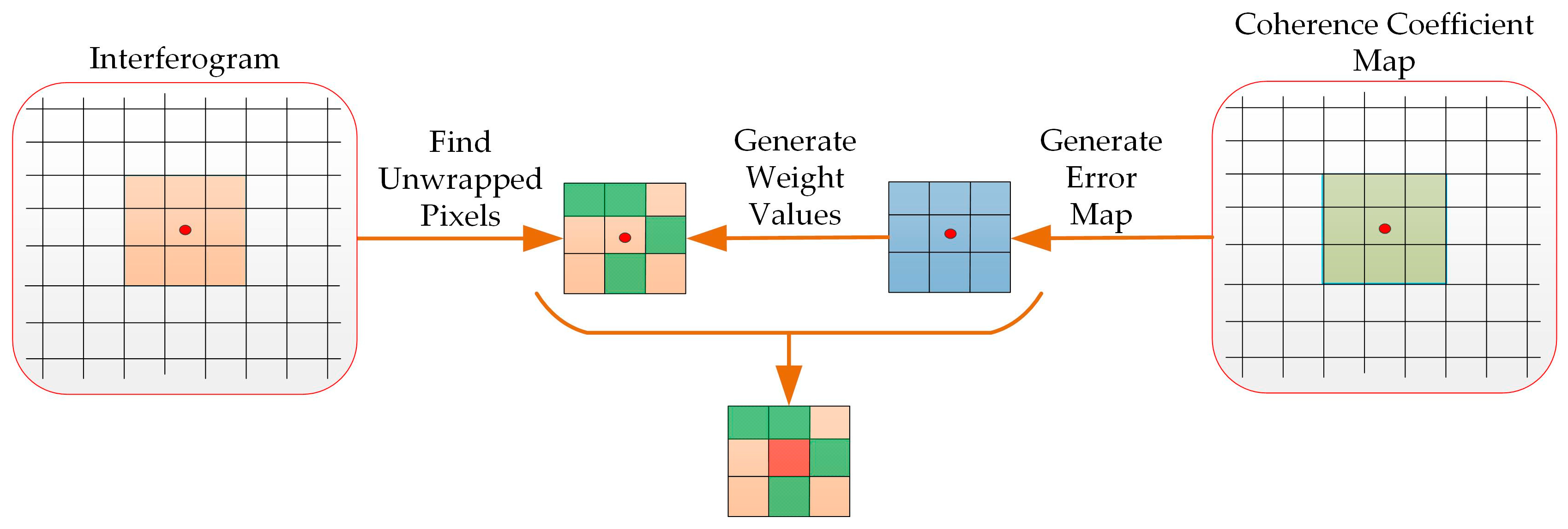

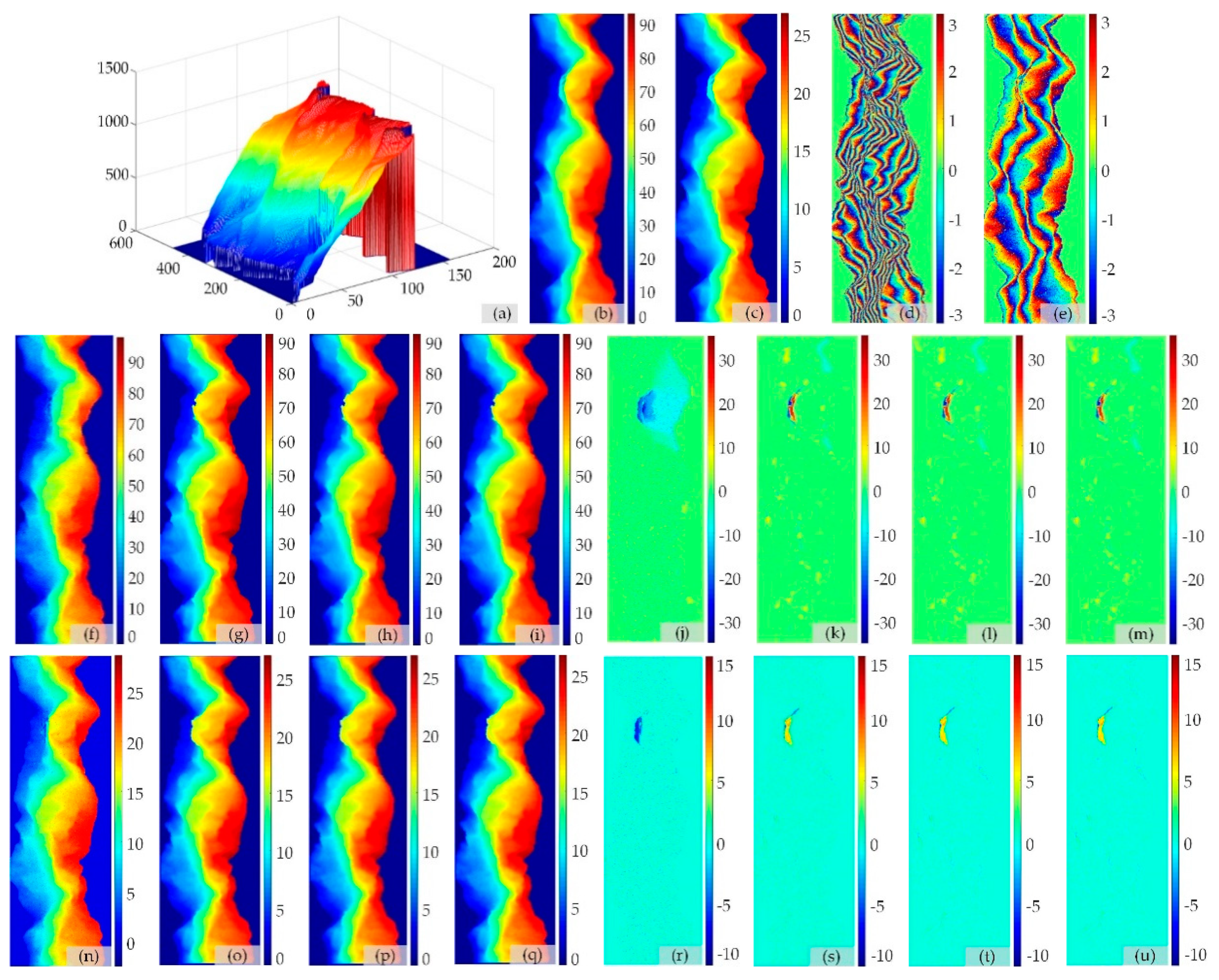
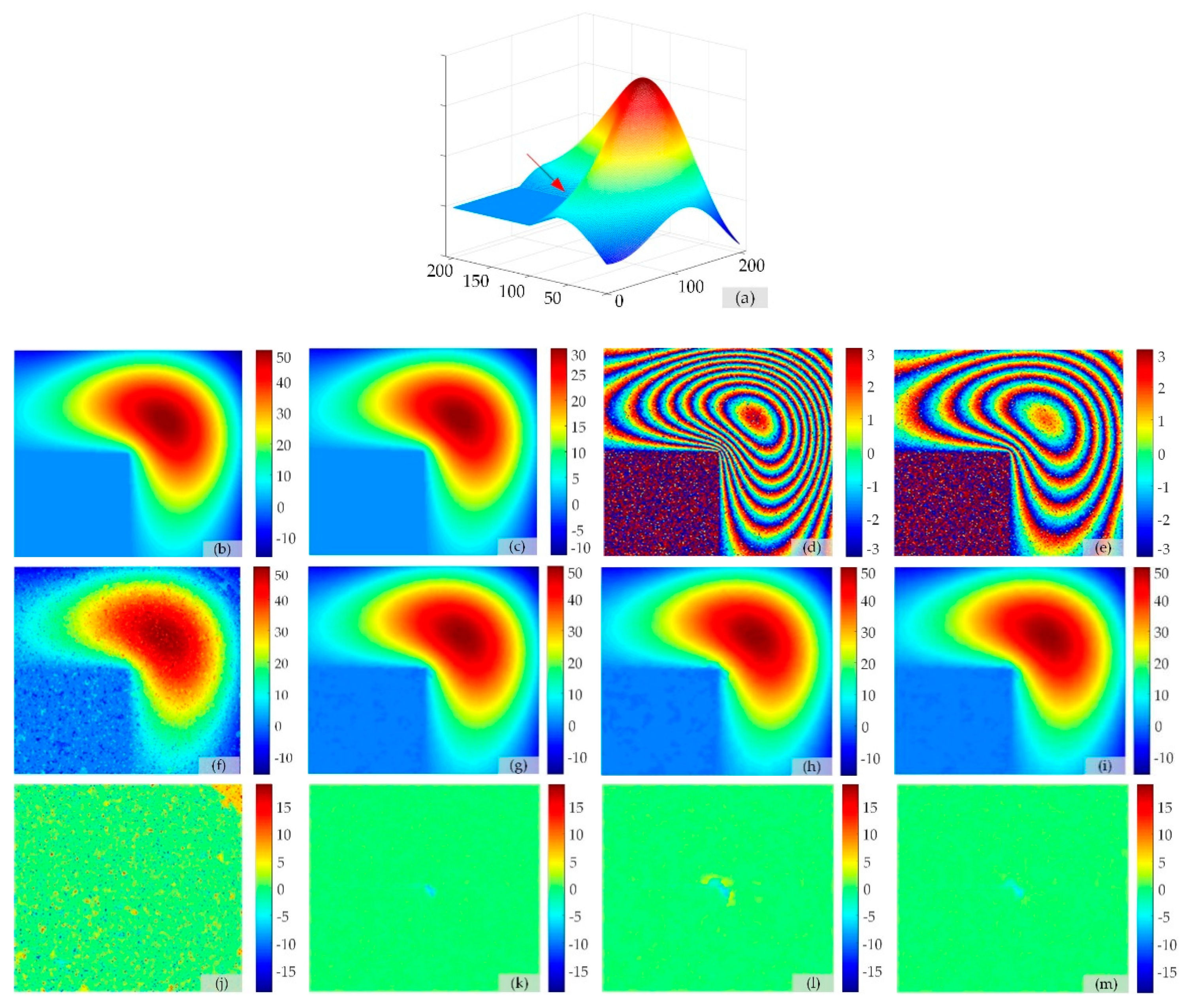
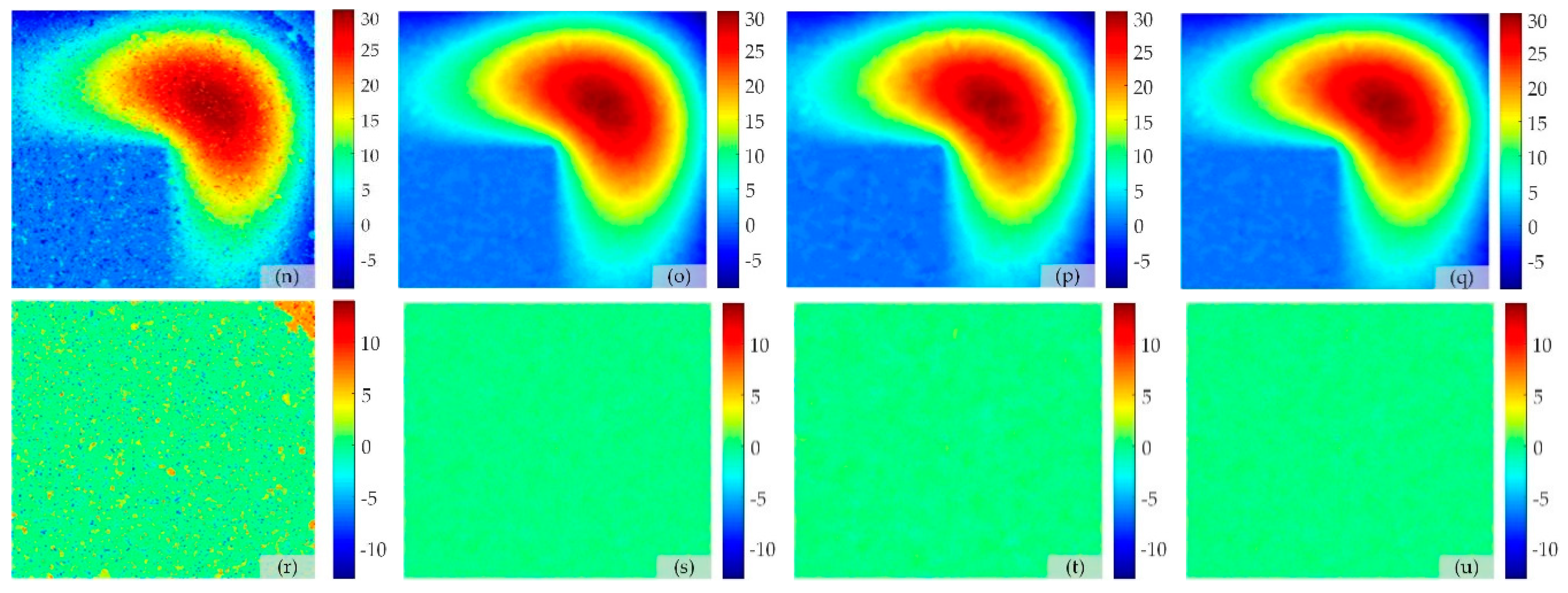
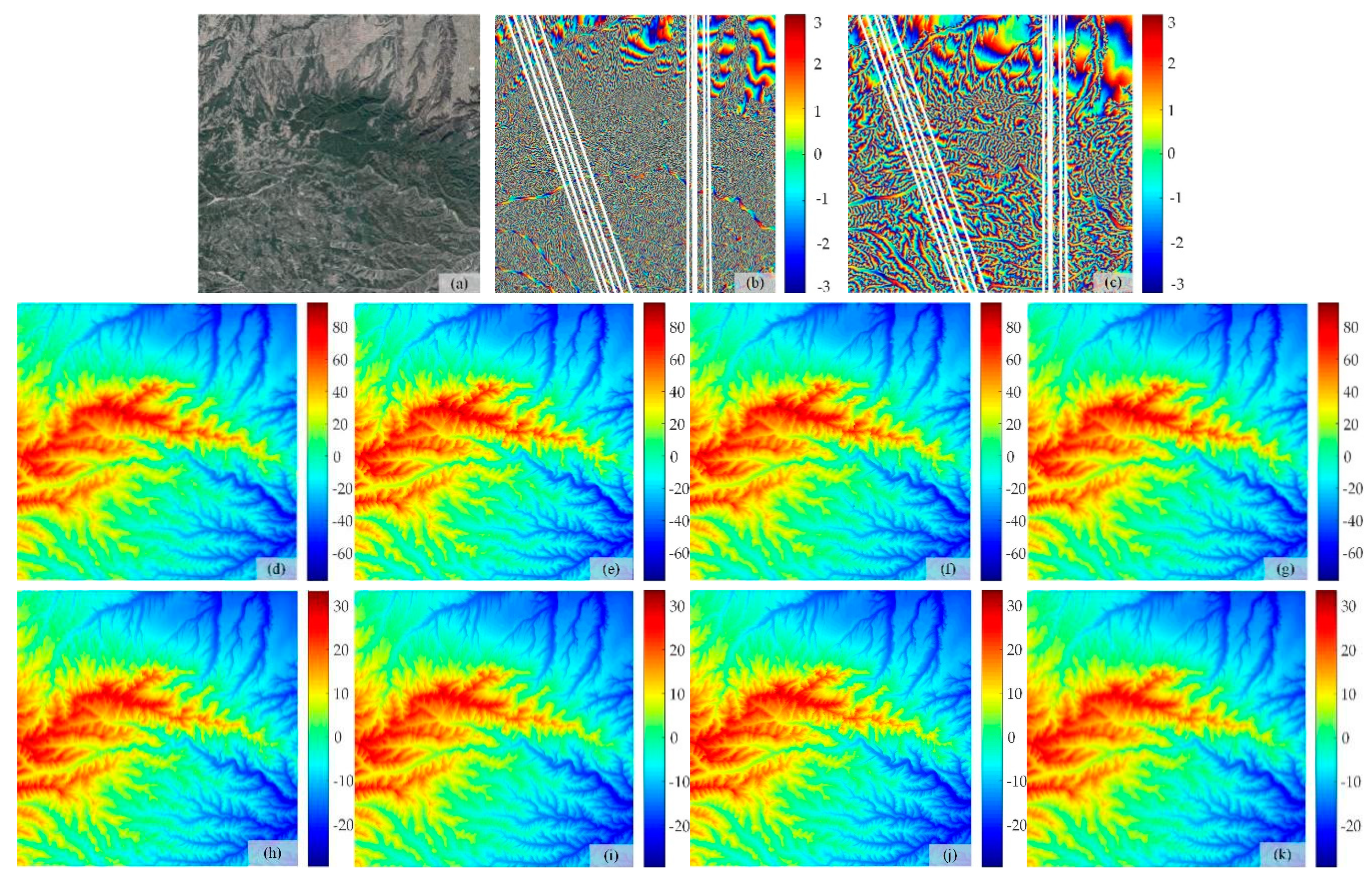
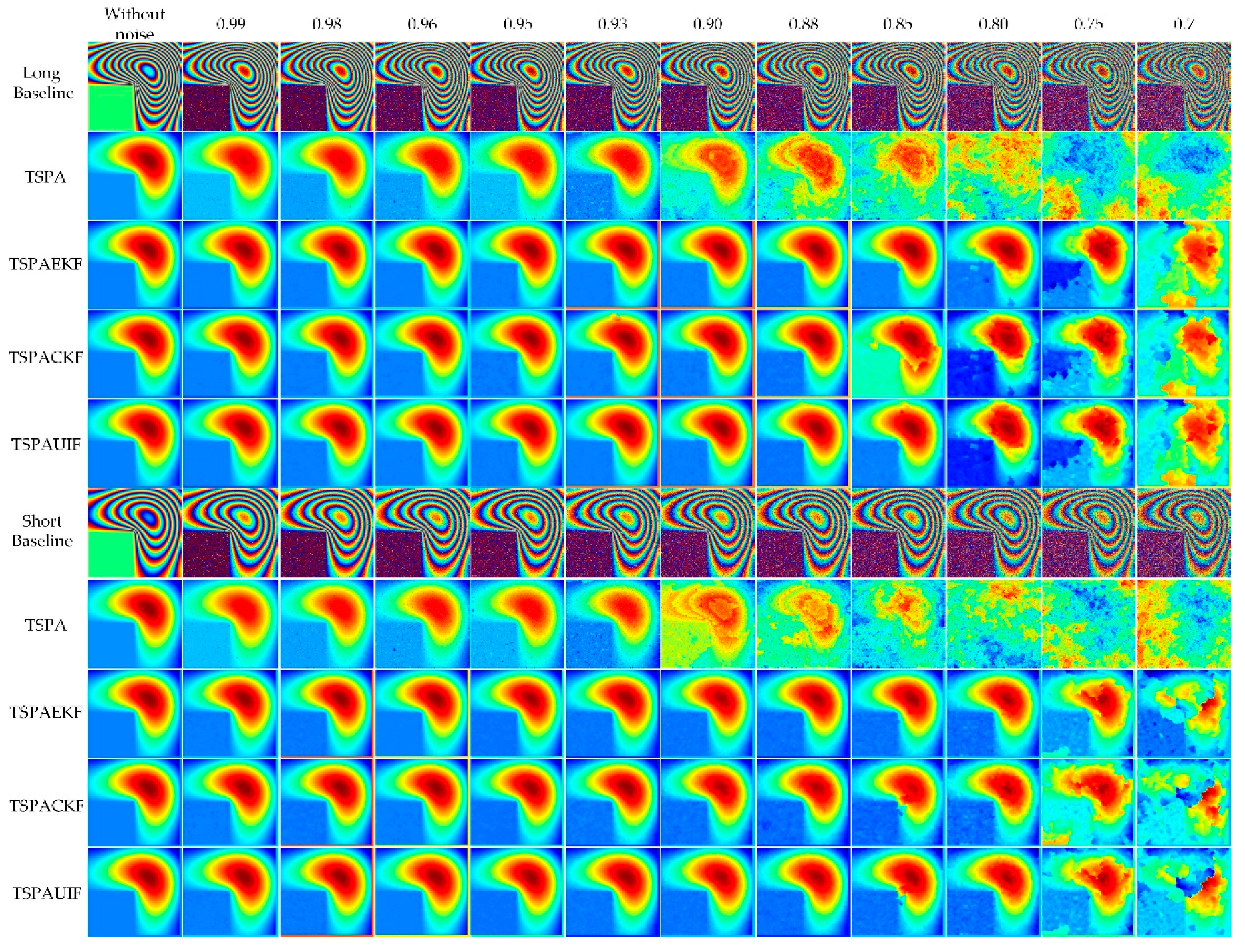
| Orbit Altitude | Incidence Angle | Wavelength |
|---|---|---|
| 600 km | 30° | 0.24 m |
| Interferogram | Figure 3d | Figure 3e |
| Normal Baseline | 389.20 m | 112.10 m |
| Mean Correlation Coefficient | 0.95 | 0.95 |
| PU Method | Long Baseline | Short Baseline | ||
|---|---|---|---|---|
| Figure | RMSE | Figure | RMSE | |
| TSPA | Figure 3j | 3.2803 | Figure 3r | 0.5734 |
| TSPAEKF | Figure 3k | 1.6736 | Figure 3s | 0.4576 |
| TSPACKF | Figure 3l | 1.6856 | Figure 3t | 0.4489 |
| TSPAUIF | Figure 3m | 1.6530 | Figure 3u | 0.4442 |
| PU Method | Long Baseline | Short Baseline | ||
|---|---|---|---|---|
| Figure | RMSE | Figure | RMSE | |
| TSPA | Figure 4j | 2.5464 | Figure 4r | 1.7760 |
| TSPAEKF | Figure 4k | 0.2865 | Figure 4s | 0.2354 |
| TSPACKF | Figure 4l | 0.3731 | Figure 4t | 0.2795 |
| TSPAUIF | Figure 4m | 0.2929 | Figure 4u | 0.2408 |
| Orbit Altitude | Incidence Angle | Wavelength |
|---|---|---|
| 514.8 km | 36.60° | 0.0320 m |
| Interferogram | Figure 5b | Figure 5c |
| Normal Baseline | −370.46 m | −127.79 m |
| Image Size | 3040 × 2315 pixels | 3040 × 2315 pixels |
| PU Method | Long Baseline | Short Baseline |
|---|---|---|
| RMSE | RMSE | |
| TSPA | 3.73 | 3.25 |
| TSPAEKF | 3.08 | 3.04 |
| TSPACKF | 3.10 | 3.10 |
| TSPAUIF | 3.05 | 3.04 |
© 2020 by the authors. Licensee MDPI, Basel, Switzerland. This article is an open access article distributed under the terms and conditions of the Creative Commons Attribution (CC BY) license (http://creativecommons.org/licenses/by/4.0/).
Share and Cite
Gao, Y.; Tang, X.; Li, T.; Chen, Q.; Zhang, X.; Li, S.; Lu, J. Bayesian Filtering Multi-Baseline Phase Unwrapping Method Based on a Two-Stage Programming Approach. Appl. Sci. 2020, 10, 3139. https://doi.org/10.3390/app10093139
Gao Y, Tang X, Li T, Chen Q, Zhang X, Li S, Lu J. Bayesian Filtering Multi-Baseline Phase Unwrapping Method Based on a Two-Stage Programming Approach. Applied Sciences. 2020; 10(9):3139. https://doi.org/10.3390/app10093139
Chicago/Turabian StyleGao, YanDong, XinMing Tang, Tao Li, QianFu Chen, Xiang Zhang, ShiJin Li, and Jing Lu. 2020. "Bayesian Filtering Multi-Baseline Phase Unwrapping Method Based on a Two-Stage Programming Approach" Applied Sciences 10, no. 9: 3139. https://doi.org/10.3390/app10093139
APA StyleGao, Y., Tang, X., Li, T., Chen, Q., Zhang, X., Li, S., & Lu, J. (2020). Bayesian Filtering Multi-Baseline Phase Unwrapping Method Based on a Two-Stage Programming Approach. Applied Sciences, 10(9), 3139. https://doi.org/10.3390/app10093139






